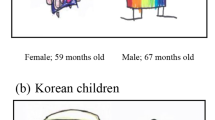Abstract
The main research objectives were (a) to study the social schemata of children on two measures: distance between figures and differences between heights of figures, the latter measure has not been previously studied; (b) to compare two types of placements, dyad vs. family placements, a parameter not previously attended to. A modified version of Kuethe’s technique was employed. Twelve figures were employed, six male and six female, designed to depict adults and children. Each of the participants, 63 boys and 64 girls, 5th graders, was instructed to place himself/herself, a father figure, a mother figure, and all three figures, three separate placements in all, on a sheet of paper measuring 80 × 42 cm. The child was free to choose one of three figures, each differing in height for both child and adult figures. Results confirmed the hypothesis that there are differences between dyad and family placements both as regards distance and height. Sex differences were also noted.
Similar content being viewed by others
References
DUHAMEL, T. R., & JARMON, H. (1971). Social schemas of emotionally disturbed boys and their male siblings. Journal of Consulting and Clinical Psychology, 2, 281–285.
ELDAN, Z. (1976). Size and distance in social schemata as a measure of family relations. Unpublished master’s thesis, Bar-Ilan University, Israel. (Hebrew).
FISHER, R. (1967). Social schema of normal and disturbed school children. Journal of Educational Psychology, 58, 88–92.
GERBER, G. L., & KASWAN, J. (1971). Expression of emotion through family grouping schemata, distance, and interpersonal focus. Journal of Consulting and Clinical Psychology, 3, 370–377.
GUARDO, C. J. (1969). Personal space in children. Child Development, 40, 141–143.
HIGGINS, J., PETERSON, J. C, & DOLBY, L. L. (1969). Social adjustment and familial schema. Journal of Abnormal Psychology, 74, 296–299.
HOBBS, N. (1966). Helping disturbed children: Psychological and ecological strategies. American Psychologist, 21, 1105–1115.
HOROWITZ, M. J., DUFF, D. F., & STRATTON, L. D. (1970). Personal space and the body buffer zone. In H. M. Proshansky, W. H. Ittleson, & L. G. Rivlin (Eds.), Environmental psychology: Man and his physical setting. New York: Holt, Rinehart & Winston.
KLOPFER, F. J., JACKSON, T. T., WOLFE, W. G., & JEFFREY, G. S. (1977). The felt figure replacement technique as a personality assessment device: Validity reconsidered. Journal of Personality Assessment, 41, 392–395.
KUETHE, J. L. (1962). Social schemas. Journal of Abnormal and Social Psychology, 64, 31–38.
KUETHE, J. L., & STRICKER, G. (1963). Man and woman: Social schemata of males and females. Psychological Reports, 13, 655–661.
O’BRIEN, R. P., & PATTON, W. F. (1974). Development of an objective scoring method for the kinetic family drawing. Journal of Personality Assessment, 38, 156–164.
RABINOWITZ, A., & SHAVIT, H. (1977), Social schemata of children, peer acceptance, and home or dormitory residence. Psychological Reports, 41, 1075–1081.
REZNIKOFF, M., & REZNIKOFF, H. R. (1956). The family drawing test: A comparative study of children’s drawings. Journal of Clinical Psychology, 12, 167–196.
STEER, R. A., THORNTON, C. C., & RITTING, C. A. (1974). Validity of the felt figure techniques: A factor analytic approach. Journal of Personality Assessment, 38, 255–262.
TOLOR, A. (1968). Psychological distance in disturbed and normal children. Psychological Reports, 23, 695–701.
TOLOR, A., CRAMER, M., D’AMICO, D., & O’MARRA, M. M. (1975). The effects of self-concept, trust, and imagined positive or negative self-disclosures on psychological space. Journal of Psychology, 89, 9–24.
TOLOR, A., WARREN, M., & WEINICK, H. M. (1971). Relation between parental impersonal styles and their children’s psychological distance. Psychological Reports, 29, 1263–1275.
WEINSTEIN, L. (1965). Social schemata of emotionally disturbed boys. Journal of Abnormal and Social Psychology, 70, 457–461.
WEINSTEIN, L. (1967). Social experience and social schemata. Journal of Personality and Social Psychology, 6, 429–434.
Author information
Authors and Affiliations
Rights and permissions
About this article
Cite this article
Rabinowitz, A., Eldan, Z. Social Schemata of Israeli Children on Measures of Distance and Height in Dyad and Family Placements. Psychol Rec 34, 343–351 (1984). https://doi.org/10.1007/BF03394878
Published:
Issue Date:
DOI: https://doi.org/10.1007/BF03394878



